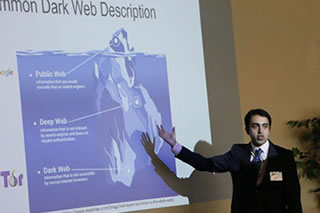News Archive
ISDS Assistant Professor's NSF Grant Will Fund Research Aimed at Protecting Scientific Instruments from Cyber Attack
By Keith Morelli

TAMPA (June 5, 2019) -- The rapidly evolving computer technologies in scientific instruments makes it possible to make huge strides in the breadth of knowledge about the universe. Such accomplishments include the discovery of the Higgs-Boson particle and the recent images of the massive black hole in space. But there remains a peril in these advancements: The systems themselves are dangerously vulnerable to attack by hackers from the dark web.
To mitigate these issues, researchers from across the United States, including Sagar Samtani, a dark web expert at the University of South Florida’s Muma College of Business who is collaborating with scientists with the University of Arizona, to work on ways to thwart the threat. They have been awarded a $1 million Cybersecurity Innovation for Cyberinfrastructor National Science Foundation grant, of which USF will receive $120,000 for research contributed by Samtani, an assistant professor in the Information Systems and Decision Sciences Department in the Muma College of Business.
Samtani received a CISE Research Initiation Initiative NSF grant this spring – the first such grant given to a business college researcher in the state of Florida – for his work identifying emerging threats from the dark web and its impact on businesses and consumers. Samtani now is collaborating with Hsinchun Chen, a renowned expert in cybersecurity at the University of Arizona, and others to launch a project aimed at protecting the scientific instruments that are uncovering previously imponderable answers.
“The same technologies contributing to these high-impact advancements are increasingly being targeted by malicious hackers for their intellectual and financial values,” says the abstract of the research project. “These attacks threaten the confidentiality, integrity and availability of carefully collected scientific data and once-in-a-lifetime scientific events.
“The full extent of scientific cyberinfrastructure vulnerabilities and the exploits targeting these flaws have not been properly mapped.”
The three-year research project partners with two large-scale scientific installations: CyVerse and Landscape Evolution Observatory, both headquartered at the University of Arizona.
Samtani said the project is designed to create a deep learning-based system that proactively identifies, categorizes and prioritizes threats in the dark web and to pinpoint attempts to hack the community-based scientific infrastructures of CyVerse and Landscape Evolution Observatory.
CyVerse is a $50 million NSF-funded multi-institution, international facility offering advanced computing resources for the life sciences community through the execution of computationally intensive tasks. LEO uses a distributed earth-based sensor network to collect environmental data for earth sciences research to answer the fundamental question of “How does life come into existence?”
“CyVerse’s and LEO’s unique blend of scientific assets and research community enables proactive investigation of current and emerging cyber-threats that can compromise scientific discoveries,” the abstract says.
Samtani said the project closely follows research he has conducted over the past few years.
“This particular project holds promise in creating interesting broader impacts given these unique partnerships,” he said. “For example, CyVerse was instrumental in processing the recent imaging of the first-ever pictures of a supermassive black hole this year.”